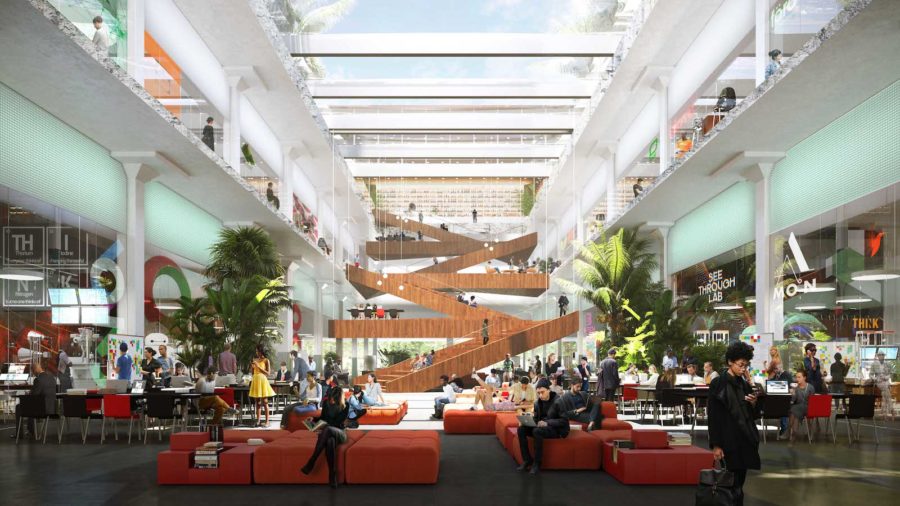沖縄の小さな南の島。宮古島に建つ複合的福祉施設。障がいをもつ子供の施設、児童発達支援と一般の子供の保育園を併設させるという全国でも珍しい施設となっている。
障がいをもつ子も一般の子も一緒に生活していくことを目標としてお互いの存在を認めつつ、大人も子供も交流していける施設づくりが目標となった。
計画として中庭を中心とした回廊型の平面計画としている。構造的な柱、壁を極端に少なくすることにした。諸室は木製建具で仕切っているが、建具を開けると保育施設、廊下、中庭、訓練室、遊戯室を見通せるようにするためである。利用者はお互いの存在を確認しながら日常生活を送ることができる。
中庭は遊び場であるが、イベント時には中庭は客室となり遊戯室は舞台となる。遊戯室や中庭で遊ぶ子供たちの声は障がいのもつ動けない子供たちにも声が届くような仕組みで、実際重度の障がいをもつ子もみんなの声が聞こえることで、笑顔も増えて活動的になったと報告を受けている。
内装については活動的に動き回る廊下や遊戯室の床はメンテナンスのしやすい塩ビタイルの床。長く座ったり触れたりする時間の多い保育室や訓練室の床は天然のコルクタイルなどと使い分けている。保育室と訓練室の天井は特徴的で三角屋根が連なるかたちを取っており、その天井にはフローリングを張っている。山のない宮古島に山のイメージと温かみのある内装を心がけた。連なった三角屋根は建築外観にも特徴を与えている。
こうして出来上がった施設は子供たちだけでなく、親や職員みんなが交流する、垣根の少ない明るい施設となっている。(比嘉 幹、安慶田健太)
An expansive welfare complex centered on a courtyard
A complex welfare facility on Miyako Island in Okinawa. It is a rare facility in Japan in that it combines a facility for children with disabilities, child development support, and a daycare center for general children. The goal was to create a facility where both children with disabilities and the general public can live together and where adults and children can interact while acknowledging each other’s existence.
The floor plan is in the form of a corridor with a courtyard at its center. I decided to minimize the number of structural columns and walls. Wooden fittings separate the rooms, and when the fittings are opened, it is possible to see through to the daycare facility, corridor, courtyard, training room, and playroom. Users can see each other as they go about their daily lives.
The courtyard is a playground, but the yard becomes a guest room during events, and the playroom becomes a stage. The voices of the children playing in the playroom and courtyard reach the disabled and immobile children. The children with severe disabilities have reported that their smiles have increased, and they are more active because they can hear the voices of everyone.
As for the interior design, the floor of the corridor and playroom, where children are active, is made of easy-to-maintain PVC tiles. The floors of the nursery and training rooms, where children spend a lot of time sitting and touching, are made of natural cork tiles. The ceilings of the nursery and training rooms have a characteristic triangular roof, and the ceilings are covered with wood flooring. I tried to create an interior with the image of mountains and warmth in Miyako Island, where there are no mountains. The interlocking triangular roofs also give the building a distinctive appearance.
The result is a bright facility with few barriers, where the children and their parents and staff can interact with each other. (Motoki Higa, Kenta Ageda)
【みやくるる】
所在地:沖縄県宮古島市
用途:児童福祉施設
クライアント:ビザライ
竣工:2019年
設計: LSDdesign
担当:比嘉 幹、安慶田健太
構造設計:本間真生
電気設備:東光電気
機械設備:松宮開発
ガス:宮古ガス
家具・建具:比嘉製作所
施工:久仲工建
撮影:石橋マサヒロ、LSDdesign(空撮のみ)
工事種別:新築
構造:RC造
規模:地上2階
敷地面積:1978.51m²
建築面積:960.64m²
延床面積:948.53m²
設計期間:2017.07-2017.12
施工期間:2018.01-2019.03
【miyakururu】
Location: Miyakojima-shi, Okinawa, Japan
Principal use: Child welfare facility
Client: Visarai
Completion: 2019
Architects: LSDdesign
Design team: Motoki Higa, Kenta Ageda
Structure engineer: Masaki Honma
Electrical equipment: Toko Electrical Construction
Mechanical equipment: Matsumiyakaihatsu
Gas: Miyakogas
Furniture: Higa seisakusho
Contractor: Hisanakakouken
Photographs: Masahiro Ishibashi / In-house (aerial photography)
Construction type: New Building
Main structure: Reinforced Concrete construction
Building scale: 2 stories
Site area: 1978.51m²
Building area: 960.64m²
Total floor area: 948.53m²
Design term: 2017.07-2017.12
Construction term: 2018.01-2019.03








